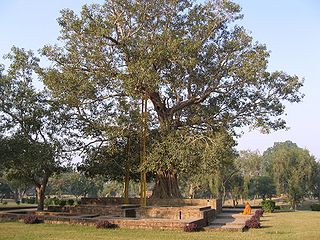Ashvattha

According to Hindu scriptures, asvattha (Sanskrit: अश्वत्थ, IAST: aśvattha) (or Assattha), that is, the sacred fig (Ficus religiosa), is a sacred tree for the Hindus and has been extensively mentioned in texts pertaining to Hinduism, for example as peepul in Rig Veda mantra I.164.20.[citation needed] In Buddhism, the Bodhi Tree under which Gautama Buddha gained enlightenment is also of the same species (Ficus religiosa).
Ashvattha is a name of Shiva and Vishnu; according to Sankara, this name is derived from the terms shva (tomorrow) and stha (that which remains).[1] The Atharvan were the recipients of gifts (given to Payu) in the Danastuti from Prince Ashvattha's generosity (Rig Veda mantra IV.47.24); the prince identified with Divodasa by Griffith.[2]
Yama, while instructing Naciketa describes the eternal Asvattha tree with its root upwards, and branches downwards, which is the pure immortal Brahman, in which all these worlds are situated, and beyond which there is nothing else (Katha Upanishad Verse II.iii.1). Meanwhile, Krishna tells us that the Asvattha tree having neither end nor beginning nor stationariness whatsoever has its roots upwards and branches downwards whose branches are nourished by the Gunas and whose infinite roots spread in the form of action in the human world which though strong are to be cut off by the forceful weapon of detachment to seek the celestial abode from which there is no return (Bhagavad Gita XV.1-4).[3] The former teaches that the Asvattha tree is real being identical with Brahman and therefore impossible to cut-off; the latter insists that the Asvattha tree must be regarded as unreal being identical with existence which needs to be cut-off. [4]
The Puranas such as the Padma Purana and the Skanda Purana enumerate the very many advantages to be secured from reverentially approaching and worshipping the Ashvattha (Peepul) tree.[5]
The first historical person named in connection with the worship of the Bodhi tree in Bodhgaya is Asoka whose Buddhist name was Piyadasi.[6]
The fire sticks used in Hindu sacrificial fire like agnihotra also contain dried wood of ashvatha tree.
See also[]
References[]
- ^ Roshan Dalal. Hinduism: An Alphabetical Guide. p. 44.
- ^ Vedic Index of Names and Subjects Vol.1. A1 Books Co. p. 17.
- ^ "Chapter 15, Verses 1-4". Bhagavad Gita. Translated by Mukundananda, Swami.
- ^ R.D.Ranade (1926). A Constructive Survey of Upanishadic Philosophy. Bharatiya Vidya Bhavan. pp. 145-146.
- ^ David L.Haberman. People Trees:Worship of Trees in Northern India. Oxford University Press. pp. 73–74.
- ^ Jan. G. Platvoet. Pluralism and Identity:Studies in Ritual Behaviour. p. 151.
- Dictionary of Hindu Lore and Legend (ISBN 0-500-51088-1) by Anna Dallapiccola
- Individual trees
- Trees in mythology
- Trees in Buddhism
- Sacred trees in Hinduism
- Hindu mythology stubs
